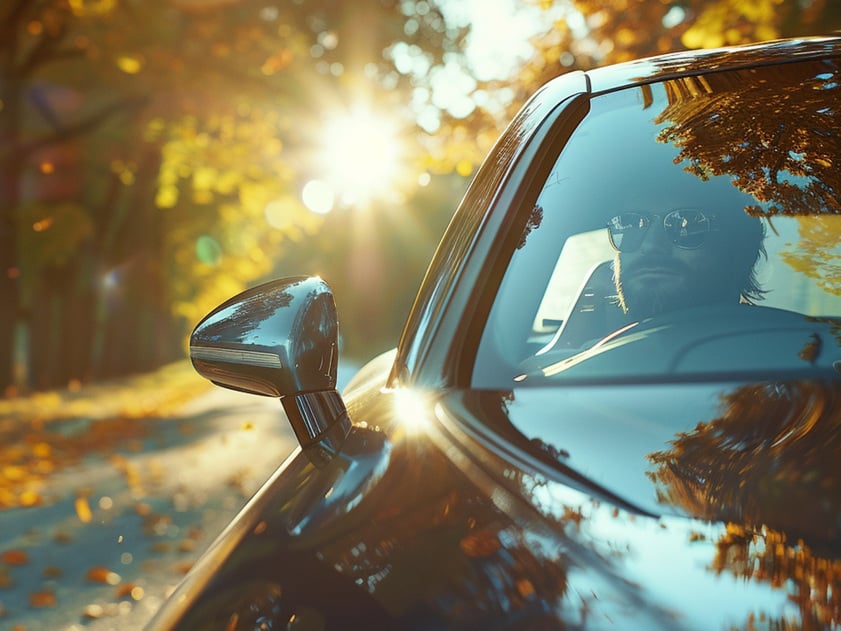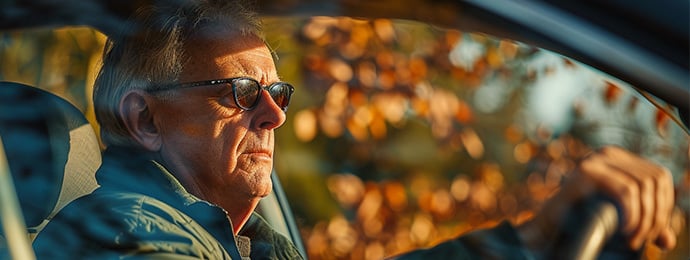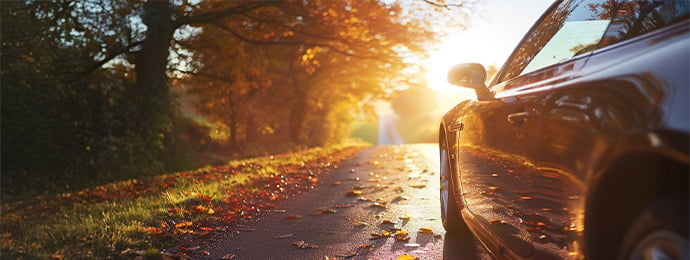
The low autumn sun can catch you off guard. When the clocks go back and you find yourself driving to work or collecting children from school in twilight, glare becomes a real hazard. Many drivers focus on stocking up on de-icer or screen wash, but few think about eye protection.
A good pair of sunglasses isn’t a fashion statement, it’s an essential piece of kit. When light reflects off wet roads or frosty windshields, it can temporarily blind you and reduce reaction time, increasing the risk of accidents. Choosing the right shades will help you stay safe and comfortable while driving.
We’ve pulled together expert advice to help you pick the perfect pair of sunglasses for driving in autumn. If you’re planning to refresh your car soon, don’t forget to browse our latest car leasing deals to find vehicles with heated windscreens and advanced driver‑assistance features.

Autumn brings a lower sun angle. Even at midday, sunlight sits closer to the horizon, making glare a regular companion. Wet roads, snow and condensation act like mirrors. A dirty windscreen intensifies this effect, scattering light and making it harder to see ahead. The Department for Transport's Road Safety Statistics data attribute nearly 4,000 injuries each year to accidents caused by sun glare. The risk isn’t just about comfort, it’s about seeing pedestrians, cyclists and traffic signals in time.
The right sunglasses shield your eyes from blinding reflections and harmful ultraviolet (UV) rays. UV radiation doesn’t disappear in cold weather, if anything reflected light from ice can cause double exposure. Wearing shades with full UVA and UVB protection reduces the chance of eye strain and conditions such as photokeratitis, pterygia and cataracts. When shopping, look for lenses that carry the CE mark and meet the European Standard BS EN 1836:2005.
Lens Darkness Categories
Tinted lenses are graded by the amount of light they allow through. Picking the right category is crucial because the law limits the darkness of your driving sunglasses. Category 2 lenses (medium tint) transmit between 18% and 43% of light and are recommended for daytime driving. Category 4 lenses only let through 3% to 8% of light and are not suitable for driving at any time. The table below summarises the categories:
Light Transmission | Category | Use | Limitations | Legal? |
|---|---|---|---|---|
80%-100% (clear) | Category 0 sunglasses | Indoor or overcast conditions | None | Yes |
43%-80% (light tint) | Category 1 sunglasses | Medium sunlight, ideal for daytime driving | Not for night driving | Yes |
18%-43% (medium tint) | Category 2 sunglasses | Medium sunlight | Not for night driving | Yes |
8%-18% (dark) | Category 3 sunglasses | Bright summer sunlight | Not for night driving | Yes |
3%-8% (very dark) | Category 4 sunglasses | Intense brightness (mountains, desert) | Not for day or night driving | No |
Lens Colour And Technology
Colour affects how you perceive the road. Experts note that grey and brown tints are often the best options for winter driving because they reduce glare while maintaining colour balance. Rose tints can help you see details more clearly and support depth perception. Whatever colour you choose, make sure the lenses block 100 % of UVA and UVB rays.
Polarised lenses are effective at cutting glare. They filter horizontally oriented light and allow vertical light through, improving visibility on wet roads. However, a note of caution, because polarised lenses reduce reflections, they can make it harder to spot icy patches. Test them with your car’s digital displays to check you can still read the dashboard.
Photochromic (variable tint) lenses may seem convenient, but they can underperform behind windscreens. The AA warns that lenses reacting only to ultraviolet light won’t darken properly in the car because glass filters out UV. Look for lenses that also respond to visible light if you need adaptive shading.
Frame Style And Safety
Frames matter too. Oversized fashion frames can block peripheral vision, and deep side arms hinder your ability to spot hazards. Opt for a design that doesn’t interfere with your view of mirrors or traffic signals. Make sure lenses have an anti‑reflection coating and are free from scratches, otherwise you risk scattering light into your eyes.

Sunglasses can really help with autumn and winter glare, but they also come with things to watch out for. Below, we have revealed the key considerations when driving in sunglasses in the colder months:
- Reduced light in low sun conditions: While sunglasses help with glare, they can make shaded areas, tunnels, or twilight hours seem much darker.
- Changing light quickly: In autumn/winter, clouds, fog, and tree cover can shift lighting conditions in seconds, so sunglasses might suddenly hinder visibility.
- Driving in the dark: Sunglasses must never be used at night or in dusk/dawn conditions with limited natural light.
- Tint strength matters: Lenses that are too dark (Category 3 or 4) may not be suitable for UK winter driving, Category 2 is generally best for variable light conditions.
- Legal restrictions: In the UK, overly dark tints (especially Category 4 lenses) are not road legal for daytime driving.
Glare is only part of the problem. Adapting your driving habits makes a big difference:
- Keep a spare pair of sunglasses in your car: AXA suggests storing a pair in the glove box so you’re never caught without protection.
- Slow down and leave more space: Low sun reduces visibility for everyone. Increase the distance to the vehicle ahead and avoid sudden stops.
- Use your sun visor and clean your glass: A dirty windscreen exaggerates glare. Top up screenwash, replace wiper blades and clean mirrors before setting off.
- Keep your headlights on at dusk: Switch on your lights just before sunset and keep them on until after sunrise. Avoid using high‑beam headlights in snowy conditions because they can worsen glare for other drivers.
- Plan ahead: If possible, avoid driving directly towards the rising or setting sun. Consider adjusting your route or timing to minimise exposure.
- Look after your eyes: Opticians such as Book an Eye Test recommend having an eye examination every two years to check your vision and keep your prescription for sunglasses up to date.
“In autumn and winter, the sun sits low in the sky, often during peak commuting hours. This creates glare that can dazzle drivers, obscure pedestrians and signals, and reduce reaction times – particularly on wet or dirty windscreens. Wearing sunglasses helps cut glare and improve visibility, but drivers should also keep their windscreen clean and maintain regular eye tests. An up-to-date prescription ensures your vision is clear and your sunglasses are effective for safe driving.”

Glare from a low sun is more than just an annoyance, it’s a significant safety concern. The right sunglasses shield your eyes, sharpen your view and cut reflections from wet roads. Choose medium‑tint lenses with full UV protection, avoid category 4 lenses, and consider polarised lenses for wet conditions. Keep your windscreen and mirrors clean, slow down and stay aware of other road users. Regular eye exams will help you maintain good vision, and a spare pair of shades in your glove box will cover you if the weather changes.
Autumn driving isn’t only about clear vision, the right vehicle makes a difference too. Whether you want the higher driving position of an SUV & 4X4 to help you cope with low sun and muddy roads, or a compact hatchback that’s easier to handle on shorter commutes, there’s a lease to suit your needs. A dependable car paired with the right driving sunglasses will make your autumn journeys safer and more comfortable. For more information, browse our in-depth car leasing guides or speak to one of our specialists at 0345 811 9595.
Originally posted: 3rd October 2025

